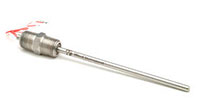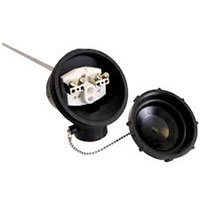
How Thermistor Sensors Work
A thermistor, short for “thermally sensitive resistor”, possesses a variable resistance that changes proportionally with temperature changes. Two types of thermistors exist: NTC thermistors (negative temperature coefficient) exhibit decreasing resistance as temperature increases, while PTC thermistors (positive temperature coefficient) increase in resistance with rising temperatures. A thermistor sensor typically uses the former, while the latter is more suited for components like heating elements or resettable fuses.
NTC thermistors are composed of semiconductor ceramics formed from powdered metal oxides pressed and sintered into shape. The composition determines the base resistance (typically defined at 25°C) and the curve describing the thermistor’s resistance as a function of temperature. The thermistor itself is highly stable, and encapsulation in epoxy resin or glass offers further resilience; a pair of electrodes completes the sensor.
Because these resistance vs temperature curves are consistent and well-measured, a thermistor sensor makes for a highly accurate thermometer, provided it’s used within the component’s specified temperature range. A thermistor sensor is also inexpensive to manufacture, requires little to no tuning and remains operable over a long lifespan.

Comparing Types of Sensors
Thermistor sensors are just one among many types of industrial temperature sensors, with thermocouple sensors and resistance temperature detectors (RTD sensors) being two other options. RTDs use wires made of platinum, nickel or copper and thermocouples operate by measuring the temperature-dependent voltage between two dissimilar leads. Each of these devices works best for particular applications due to various advantages and disadvantages:
- Temperature ranges: Thermistors are usually limited to -50 to 250°C, while RTDs are effective at lower and higher temperatures. Thermocouples have the broadest effective range, with some functioning at temperatures up to 1750°C.
- Sensitivity and accuracy: A thermistor sensor, on average, is the most sensitive to temperature changes and gives the finest accuracy of the three sensor types, potentially within 0.1°C; thermocouples are the least precise, with errors usually at least 1°C.
- Response time: Thermistors react to changes in temperature the most quickly, followed by thermocouples. RTDs show relatively slow responses.
- Power required: Thermocouples are self-powered, providing their own voltage; thermistors and RTDs function with an outside current.
- Stability: Thermistors and RTDs have high long-term stability, while thermocouple leads can degrade more quickly with use.
- Linearity: Thermistors and thermocouples have non-linear curves, in contrast with the linear resistance-temperature curve of an RTD.
- Cost: Thermistors and, to a greater extent, thermocouples are inexpensive, while RTDs typically cost more to fabricate.
Essentially, thermistors work best for cost-effectiveness and high accuracy at modest temperatures. RTDs remain accurate over wider temperature ranges, to a lesser degree, while thermocouples are the most economic choice and can function in even more extreme conditions.
Thermistor Sensor vs RTD Sensor
This sensor is a type of resistor whose resistance varies significantly with temperature, more so than in standard resistors. Thermistors differ from resistance temperature detectors (RTDs) in that the material used in a thermistor is generally a ceramic or polymer, while RTDs use pure metals.
The temperature response is also different; RTDs are useful over larger temperature ranges, while thermistors typically achieve a higher precision within a limited temperature range, typically −75 °C to 500 °F. These sensors are mainly used for automotive purposes.
Compare heat sensor and temperature control options today. At Hi-Watt, we work with a range of thermocouple and thermistor sensor options and understand the pros and cons of each type. Explore the differences between these temperature measurement devices today to find the best solution for your application today.
Thermistor vs Thermocouple
You need a sensor that will offer the exact specifications you need. Here are some basic features to use when comparing these two sensor types:
- Accurate readings
- Stable sensor design
- Durable packaging
- Rapid response times
- Acceptable temperature range
- Proper noise immunity
Use these features and your specific application to determine the ideal option. When in doubt, work with Hi-Watt to find which sensor option will offer you dependable readings.
Explore the differences in common industrial applications. While thermistors typically offer a more accurate temperature measurement, thermocouples are capable of handling larger temperature ranges. These are the most basic differences, but learn more about each sensor option to more accurately compare temperature readers for your application.
NTC Thermistors
Typically made of sintered semiconductor materials, negative temperature coefficient, or NTC, thermistors use a mix of metal oxides to allow current flow. The thermistor measures the change in resistance that is proportional to the change in temperature.
High resistance in this type of thermistor occurs at low temperatures, and the resistance decreases as the temperature increases. This allows a quick, accurate reading of temperature changes.
Calibrating the resistance and temperature of an NTC thermistor requires the thermistor beta formula. Once properly calibrated and linearized, the information from this type of sensor can be used in temperature applications between -50 degrees Celsius and 250 degrees Celsius.
Thermistor Applications
Choose the type of NTC thermistor to discover the many applications for this sensor option. Here are just a few probe assembly styles you can choose for your industrial application:
- Chip
- Disc
- Surface mount
- Glass encapsulated
Use these sensors for medical, aerospace, automotive, energy and HVAC applications. Most processes use NTC thermistors to determine temperature characteristics based on resistance, but these sensors can also be used to measure voltage-current and current-time information.
Watlow Thermistor
Which thermistor sensor is the right choice? If you’re replacing a sensor in an installation, you need to match the base resistance and resistance-temperature curve of the previous sensor, which generally means using the same thermistor composition.
Otherwise, it depends primarily on the environment and temperature in which the sensor will operate. The RT curve should encompass the expected operating temperature range, but consider whether curve-matching or point-matching is most important, depending on how wide the operating range is.
Also, the sensor should have a suitable housing that can fit in and withstand the installation to maximize stability—glass enclosures usually have the highest stability. Thermistor sensors also exist in probe configurations for diagnostics instead of regulation.
For all industrial temperature sensor needs, Hi-Watt has the thermistor to match and the expertise to find it. We carry a wide range of sensors by top brands including Watlow and others. We also carry thermocouples, PID controllers, infrared heaters and more. Contact us today for all your industrial electric heater needs, we are here to help!
Accurate and Reliable
From food processing to automotive systems, accurate and reliable temperature readings matter a great deal in many industries to keep equipment running smoothly and products safe and high-quality. At Hi-Watt, Inc., we carry a wide selection of industrial temperature sensor for any need. For the best in precision and sensitivity, though, a thermistor sensor is the answer.
Speak with an expert
Over last 8 years we have addressed 95% of inside sales quoting requests within 3 hours.
